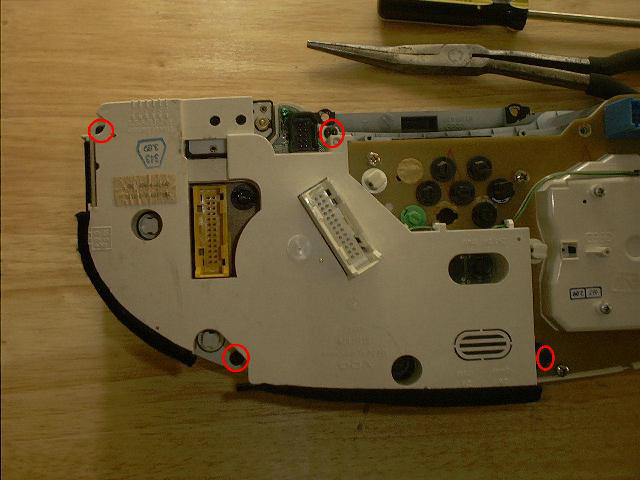
AW Post from "QCrazy"
Purpose: As Audi's age, problems with the speedometer circuitry can surface. My 1990 CQ was recently hit with a speedometer problem. To make things worse there are very few CQ clusters available on the used market. I also wanted to keep my odometer reading the same, which complicated switching in another speedometer anyway. Even if I found a speedometer that would work I would have to find one with less miles and then pulse it so that it read correctly. Therefore, to fix my speedometer problem I had to fix it using parts I had lying around or could readily purchase. The following is the procedure I used. I will also include other speedometer troubleshooting tips along the way for people to use with their own speedometer problems. This procedure ONLY applies to Audi's with electronic speedometers.Tools needed: Phillips screwdriver (Torx screwdriver on the newer vehicles) Small phillips screwdriver Flathead screwdriver Small flathead screwdriver Pliers Digital multimeter Soldering iron House paint opener (discussed later)
Problem Determination: There are a couple different areas that can give you problems with your speedometer. When you first have trouble you need to determine what exactly isn't working. Here's a few things that you can check when your speedometer quits working to help zero in on the problem. Option One: The speedometer and the odometer quit together. On the B4's you MAY get a MIL when this happens. If you have a B4 and you lose both the speedometer and the odometer and get an MIL; then your ECU is not getting a signal from your vehicle speed sensor (VSS). This could be a wiring problem or a bad VSS. What the MIL tells you is that the ECU is not getting a speedometer signal. This means the break in the wiring will be between the ECU and the VSS, or could be the VSS itself. Look at your Bentley to determine the best place to check the wiring for this problem. If you have a B3 (or a B4 with no MIL) and you lose the speedometer and the odometer you also have a wiring or VSS problem. No MIL for the B4's indicates that the ECU is getting a signal. This will change where you start checking the wiring. In this instance it could be a problem in the cluster itself. The B3's don't have the luxury of MIL's. Therefore, with the B3's you have to start at one end (cluster or VSS) and go in one direction. I would start at the VSS and make sure it's sending a signal, then check the wiring, then check the cluster. Option two: The speedometer works but the odometer quit working. This is a problem with the speedometer unit, or rather the odometer itself. Usually it's a problem with the gear on the odometer or the shaft that spins. The procedure below will tell you how to open up the cluster to inspect the speedometer and find your problem. However, this article does not go into detail on how to fix/inspect odometer problems. Options three: The speedometer quits working but the odometer continues working. This indicates that the signal is getting to the cluster and to the speedometer unit, but the signal is not getting to the speedometer portion of the unit. This situation indicates that you will need to remove the speedometer unit and find the problem. This is the situation that I had, and is what the rest of the article is devoted to.
Procedure: Step one: Remove the cluster from the car and take it to a well lit area to work. If you do not know how to remove the cluster there are websites that illustrate the procedure. Here's one: The Audi 80 Pages - Cluster Removal If you have trouble removing the cluster, then I suggest you don't attempt this procedure. Step two: The first step is to remove the auto-check system on equipped vehicles. This is done by removing about four screws.

Once the screws are removed you need to disconnect a small circuit that runs across the cluster. This circuit just simply unclips and is shown below.
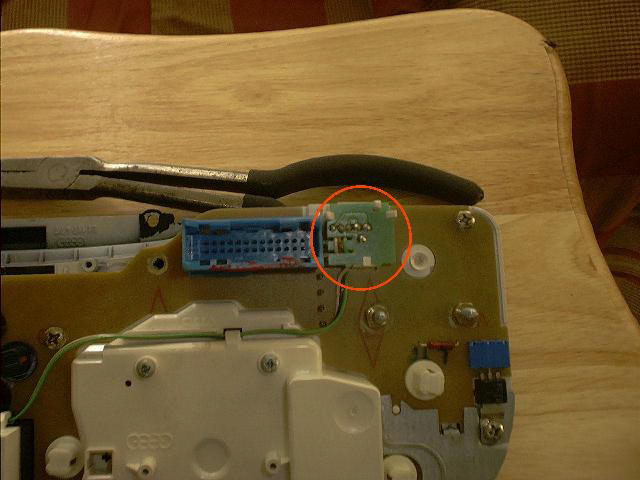
Next, pull the wire away from the cluster so the circuit is not restrained. Then pull the auto-check system straight out. Step three: The next step is to remove the rheostat. This is done by removing the nuts circled below.
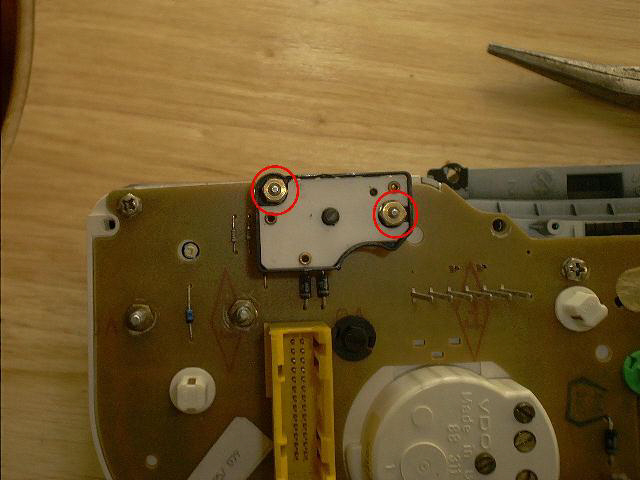
Then pull the rheostat straight out. Step four: Now the screws that hold the back of speedometer need to be removed. The following picture indicates the speedometer screws in orange. Automatic cars or B4's equipped with an outside temperature display will have an electrical connector that needs to have its screws removed where the blue circles are located.

The yellow square indicates the data tag for the speedometer unit. The CQ tag is listed with a K=6765. This number is the number of pulses per mile. Using this number a frequency can be determined for any speed. This is helpful if you need to pulse a new unit so that the speedometer reads the correct odometer. This K value also allows you to get a used cluster that will work properly in your car. The CQ K value is different from all other B3 models and is also different from the B4's. Step five: Next, remove the screws along the outside of the cluster. There will be approximately 11 of these screws. The newer clusters use torx heads.
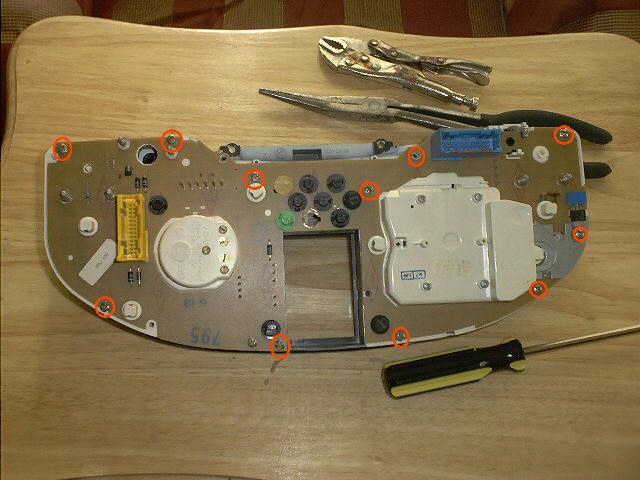
Once these screws are removed the cluster circuit board will be free. You can carefully pull the circuit board off and get ready to dig into the speedometer. If you were having problems with both the odometer AND the speedometer than this is likely as far as you'll need to go. Step six: Now that you have the speedometer, you need to disassemble it. The first step is to remove the speedometer needle. This needle is just pressed on but is still quite hard to remove. You should also remove the two screws next to the needle.

The tool I like to use to remove the speedometer needle is a house paint opener. I find this seems to be the easiest way to remove the needle. Push the turned up edge right next to the pin connecting to the needle. Then pry down on the tool (which pushes up on the needle) and at the same time pull up on the opposite side of the needle with your other hand. You may break off the black center cover but that can be glued back on. This is by far the HARDEST part. Here's what the tool looks like...
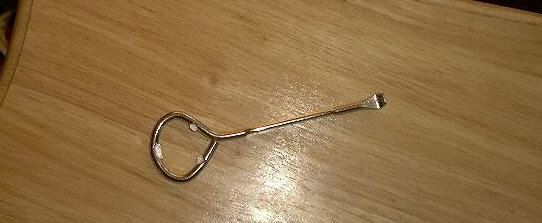
Step seven: Once the needle and screws are removed the numbered cover can be removed which exposes two more screws. Remove these screws, circled below.
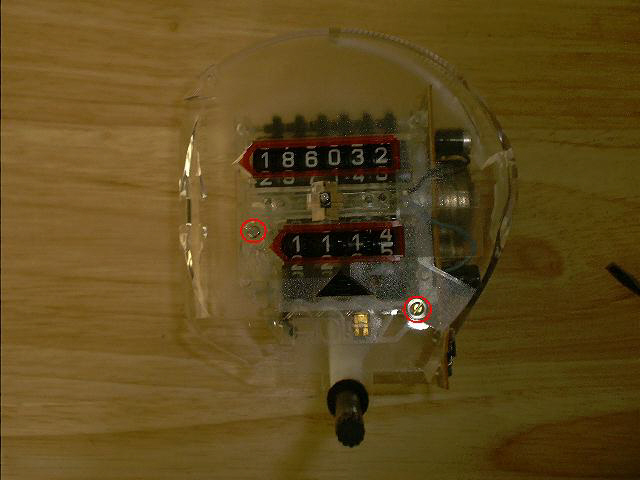
Step eight: Next, remove the odometer screws. Flip the odometer on its side and removed the screws circled below.
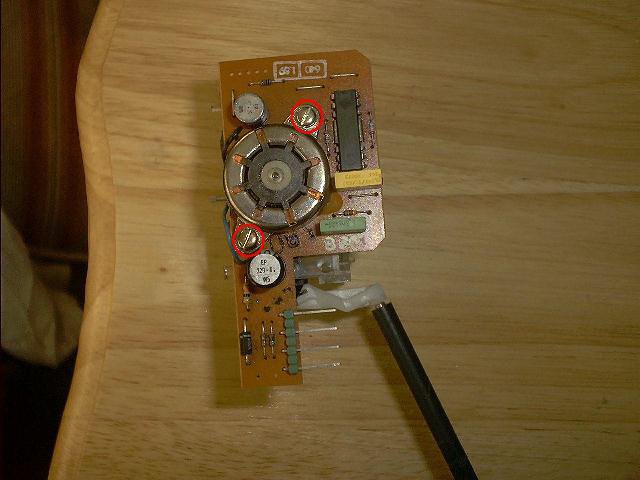
Step nine: Now the speedometer circuit board is free. You can pull the circuit board off and look for the problem. When you pull the circuit board off make sure to note the orientation of the odometer gears, place them back on the same way they came out. Also, make sure you don't lose the smaller yellow gear (gears shown in the upper left corner of the picture below). Check over all the solder joints and look for any that look strange; these could be cold joints. If you are unsure, it won't hurt to hit them with the soldering iron quickly just to be sure.
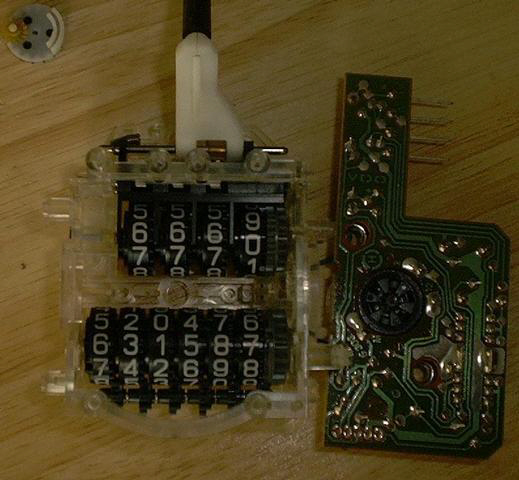
The next picture is a close-up of the odometer gears for the odometer motor. The yellow gear will fall off the white plate so be careful not to lose it.

One very important item to check is the capacitors. The capacitors are circled in the picture below.
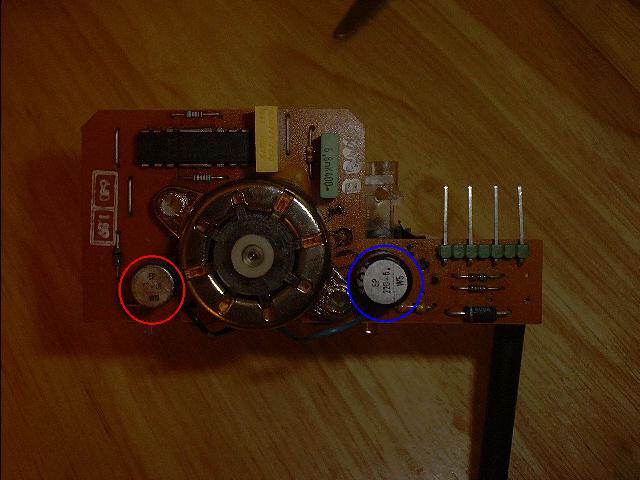
Each capacitors above has two pins that go through to the other side. On each
capacitor, locate and test these two pins for continuity (ohms). You should read
infinite ohms (open circuit). The one circled in blue was shorted on my car.
Shorting of this capacitor created a short between the positive and negative
connections to the speedometer motor. Hence, my speedometer quit working.
I got a replacement capacitor from a spare cluster I had laying around. If you want to do this make SURE the numbers on the top of the capacitors match. These capacitors changed over the years so they are NOT all the same. If you don't have a spare cluster with the correct capacitor then you can order a new one from Digi-Key. Digi-Key Step ten: If the circuit board tested okay than the only item left is your speedometer motor. Four plastic tabs hold the speedometer motor in place. Use a small screwdriver to pry the tabs back and pop it out.
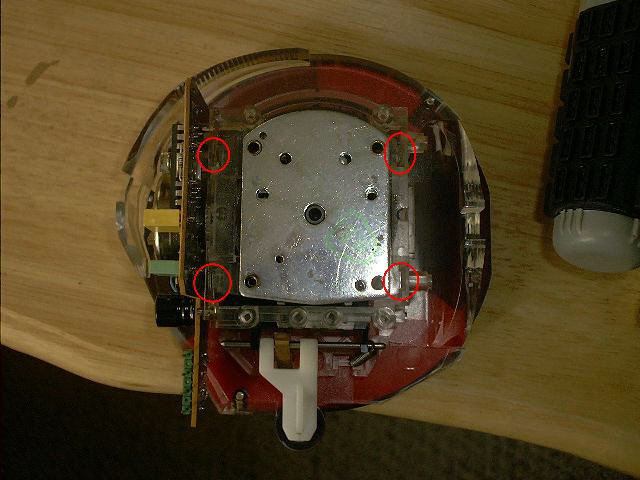
Once the speedometer motor is out you can test it by using you car battery. Jump the positive and negative speedometer motor pins to your battery. It should swing the arm quickly. If not, the motor is shot. Reverse the procedures to put everything back together. Be very careful when re-installing the speedometer motor. The speedometer motor pin projects past the face of the speedometer unit, therefore, you can NOT lay the speedometer unit on its face when re-installing the motor. If you do you'll push the pin into the table and bend, if not break, the pin. This procedure can be completed quite easily in 60 minutes.
Keywords: Speedometer, odometer, troubleshooting, VSS, cluster, circuit
Disclaimer: This is the procedure that I used to repair the speedometer on my 1990 CQ. This procedure will be applicable to all B3 and B4 80/90's. It will also most likely apply to all cars built in the 90's and those cars built in the 80's with electronic speedometers. The previous was just a description of the procedure I used to repair my speedometer. Attempt at your own risk.